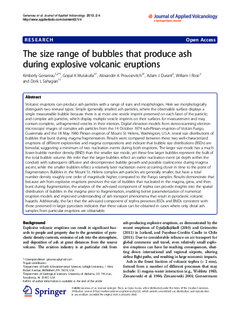| dc.contributor.author | Genareau, Kimberly | |
| dc.contributor.author | Mulukutla, Gopal K. | |
| dc.contributor.author | Proussevitch, Alexander A. | |
| dc.contributor.author | Durant, Adam John | |
| dc.contributor.author | Rose, William I. | |
| dc.contributor.author | Sahagian, Dork L. | |
| dc.date.accessioned | 2018-04-26T11:44:06Z | |
| dc.date.available | 2018-04-26T11:44:06Z | |
| dc.date.created | 2014-02-20T14:59:24Z | |
| dc.date.issued | 2013 | |
| dc.identifier.citation | Genareau, K., Mulukutla, G.K., Proussevitch, A.A., Durant, A.J., Rose, W.I., Sahagian, D.L. (2013). The size range of bubbles that produce ash during explosive volcanic eruptions. J. Appl. Volcanol., 2, 4, doi:10.1186/2191-5040-2-4 | nb_NO |
| dc.identifier.issn | 2191-5040 | |
| dc.identifier.uri | http://hdl.handle.net/11250/2496136 | |
| dc.description.abstract | Volcanic eruptions can produce ash particles with a range of sizes and morphologies. Here we morphologically distinguish two textural types: Simple (generally smaller) ash particles, where the observable surface displays a single measureable bubble because there is at most one vesicle imprint preserved on each facet of the particle; and complex ash particles, which display multiple vesicle imprints on their surfaces for measurement and may contain complete, unfragmented vesicles in their interiors. Digital elevation models from stereo-scanning electron microscopic images of complex ash particles from the 14 October 1974 sub-Plinian eruption of Volcán Fuego, Guatemala and the 18 May 1980 Plinian eruption of Mount St. Helens, Washington, U.S.A. reveal size distributions of bubbles that burst during magma fragmentation. Results were compared between these two well-characterized eruptions of different explosivities and magma compositions and indicate that bubble size distributions (BSDs) are bimodal, suggesting a minimum of two nucleation events during both eruptions. The larger size mode has a much lower bubble number density (BND) than the smaller size mode, yet these few larger bubbles represent the bulk of the total bubble volume. We infer that the larger bubbles reflect an earlier nucleation event (at depth within the conduit) with subsequent diffusive and decompressive bubble growth and possible coalescence during magma ascent, while the smaller bubbles reflect a relatively later nucleation event occurring closer in time to the point of fragmentation. Bubbles in the Mount St. Helens complex ash particles are generally smaller, but have a total number density roughly one order of magnitude higher, compared to the Fuego samples. Results demonstrate that because ash from explosive eruptions preserves the size of bubbles that nucleated in the magma, grew, and then burst during fragmentation, the analysis of the ash-sized component of tephra can provide insights into the spatial distribution of bubbles in the magma prior to fragmentation, enabling better parameterization of numerical eruption models and improved understanding of ash transport phenomena that result in pyroclastic volcanic hazards. Additionally, the fact that the ash-sized component of tephra preserves BSDs and BNDs consistent with those preserved in larger pyroclasts indicates that these values can be obtained in cases where only distal ash samples from particular eruptions are obtainable. | nb_NO |
| dc.language.iso | eng | nb_NO |
| dc.rights | Navngivelse 4.0 Internasjonal | * |
| dc.rights.uri | http://creativecommons.org/licenses/by/4.0/deed.no | * |
| dc.title | The size range of bubbles that produce ash during explosive volcanic eruptions | nb_NO |
| dc.type | Journal article | nb_NO |
| dc.type | Peer reviewed | nb_NO |
| dc.description.version | publishedVersion | nb_NO |
| dc.rights.holder | © Genareau et al.; licensee Springer. 2013 | nb_NO |
| dc.source.volume | 2 | nb_NO |
| dc.source.journal | Journal of Applied Volcanology | nb_NO |
| dc.identifier.doi | 10.1186/2191-5040-2-4 | |
| dc.identifier.cristin | 1117169 | |
| dc.relation.project | NILU: 112109 | nb_NO |
| cristin.unitcode | 7460,57,0,0 | |
| cristin.unitname | Atmosfære og klima | |
| cristin.ispublished | true | |
| cristin.fulltext | original | |
| cristin.qualitycode | 1 | |

